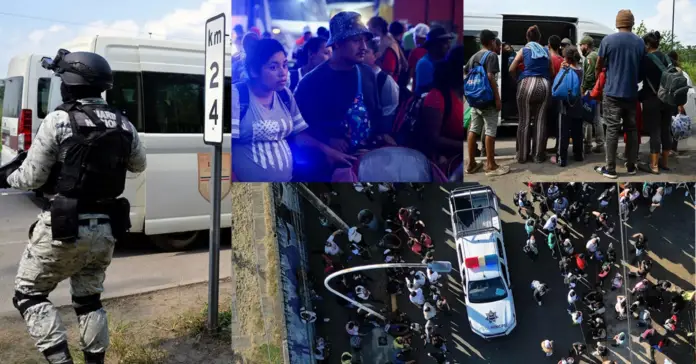The three states in the country with the largest presence of irregular migrants are also hot spots for violence and insecurity that endanger the thousands of Central American citizens and those of other nationalities who walk through their territory.
Tabasco, Chiapas and Baja California account for 85.9% of migrants without legal status and at the same time, they are experiencing a wave of violence due to disputes between organizations such as the Sinaloa and Jalisco Nueva Generación cartels.
According to data from the Ministry of the Interior, as of August 2024 (last available data), there were 925,085 irregular migrants registered in Mexico, of which 442,365 were in Tabasco; 315,887 in Chiapas; and 37,229 in Baja California.
In these states, the number of irregular migrants increased by 297%, 138% and 92%, respectively, between 2023 and 2024.
During 2024, at least 109 migrants in an irregular situation, according to data from the Migration Policy, Registration and Identity of Persons Unit.
Migrants in Mexico are the target of crimes such as kidnapping, forced disappearance and other types of illegal deprivation of liberty. However, impunity for crimes committed against migrants is 99%, according to the report ‘Access to justice for migrants in Mexico: a right that exists only on paper’, carried out by the Washington Office on Latin American Affairs (WOLA).
The Human Rights Watch World Report 2025 warns that migrants and asylum seekers in Mexico are “often” victims of serious abuses, including by officials.
It notes that the refugee agency (Comar) is overwhelmed despite having expanded its number of offices and documented that, between January and July of last year alone, federal authorities carried out 830 thousand “apprehensions” of migrants.
“Many migrants apprehended in northern Mexico, some 10,000 a month, including some who have an appointment, are sent south by bus. Migrants and asylum seekers are often victims of serious abuses, including sexual violence, armed robbery, kidnapping and extortion, committed by criminal groups or Mexican officials,” warns the document published in January.
“During López Obrador’s presidency, the national refugee agency expanded its presence. It went from having 4 offices in 2018 to having 13 in 2024, with the support of the United Nations refugee agency. However, the system remains overwhelmed.
Tabasco
Tabasco is in the lead, with 442,365 irregular migrants registered from January to August 2024, according to data from the Migration Policy, Registration and Identity of Persons Unit of the Ministry of the Interior. The state has been marked by clashes between two criminal organizations: the Jalisco Nueva Generación Cartel (CJNG) and La Barredora.
Both groups, one with a national presence and the other local, fight over territory to carry out criminal activities such as extortion and protection, as well as drug sales, the trade in huachicol (stolen fuel) and migrant trafficking.
The capture of the leader of La Barredora, Carlos Tomás ‘N’, alias “El Lic” or “El Tomasín”, on January 19, led to a wave of violence that included armed clashes between authorities and security elements, burning of vehicles and commercial premises, as well as the appearance of the bodies of torture victims.
During 2024, 921 victims of intentional homicide were recorded in Tabasco, with a rate of 34.4 murder victims per 100,000 inhabitants, above the national rate, which is 23.3.
With 95.3% of the inhabitants of Villahermosa considering that living there is unsafe, the capital of Tabasco is ranked first nationally in perception of insecurity, according to the latest National Urban Security Survey (ENSU) of INEGI.
This entity in the south of the country occupies second place nationally for the number of migrants in an irregular situation, with 315,887.
In Chiapas, the rate of intentional homicide victims per 100,000 inhabitants has nearly doubled in the last two years, going from 8 victims in 2022 to 15.4 victims in 2024.
Between 2010 and 2021, around 14,476 people were displaced from their communities by the presence of illegal armed groups, according to the Fray Bartolomé de las Casas Human Rights Center (CDH).
Chiapas has also suffered the forced displacement of its inhabitants to Guatemala. In 2024, dozens of its inhabitants crossed the southern border, leaving their homes and communities to save their lives in the dispute over territory between cells of the Sinaloa Cartel (CDS) and the Jalisco Nueva Generación Cartel. The state is a key point for drug trafficking from Central and South America.
An example of this displacement was the attack in July 2024 in Nuevo Reforma, municipality of Chicomuselo, where nearly 400 people fled after drone grenades were launched on their community.
Chiapas has two of the five cities with the highest perception of insecurity in the country: Tuxtla Gutiérrez, with 90.6% (third place nationally), and Tapachula with 90.1% of its inhabitants (fourth place), according to the ENSU published last month.
By number of illegal migrants, in third place is Baja California, an entity that registered the presence of 37,229 migrants in 2024. Both the Sinaloa Cartel and the Jalisco Nueva Generación Cartel fight for control of the entity.
The epicenter of violence in this entity is the border city of Tijuana. In Baja California, a total of 2,090 intentional homicides were recorded during 2024, with 62.3 victims per 100,000 inhabitants, nearly three times the national rate.
The United States Government even issued a travel alert in 2024 where it recommended its citizens reconsider their trips to seven states in Mexico, including Baja California, due to the crime rate, especially kidnapping.

Source: politica.expansion




